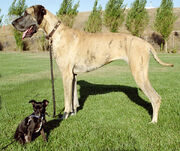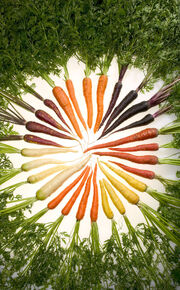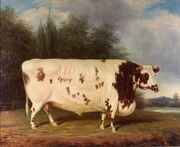Assessment |
Biopsychology |
Comparative |
Cognitive |
Developmental |
Language |
Individual differences |
Personality |
Philosophy |
Social |
Methods |
Statistics |
Clinical |
Educational |
Industrial |
Professional items |
World psychology |
Biological: Behavioural genetics · Evolutionary psychology · Neuroanatomy · Neurochemistry · Neuroendocrinology · Neuroscience · Psychoneuroimmunology · Physiological Psychology · Psychopharmacology (Index, Outline)

This Chihuahua mix and Great Dane show the wide range of dog breed sizes created using artificial selection.

Carrots selectively bred to produce different of white and black.
Artificial selection is the breeding of certain traits over others. It was originally defined by Charles Darwin in contrast to the process of natural selection, in which the differential reproduction of organisms with certain traits is attributed to improved survival and reproductive ability in the natural habitat of the organism. Artificial selection that produces an undesirable outcome from a human perspective is sometimes called negative selection (but note that this term has a better-established meaning as a type of natural selection).
Historical development[]
Charles Darwin originally coined the term as an illustration of his proposed wider process of natural selection. He noted that many domesticated animals and plants had special properties that were developed by intentionally encouraging the breeding potential of individuals who both possessed desirable characteristics, and discouraging the breeding of individuals who had less desirable characteristics.
Contrast to natural selection[]
The difference between natural and artificial selection centers on the difference in environment among organisms subject to the two processes. Essentially, in artificial selection, the fitness which is the amount of offsping an individual contributes to a population relative to other individuals in that same population of an organism is defined in part by its display of the traits being selected for by humans. Since humans either intentionally or unintentionally exert control over which organisms in a population reproduce or how many offspring they produce, the distribution of traits in the organisms' population will change.
It should be emphasized that there is no real difference in the genetic processes underlying artificial and natural selection, and that the concept of artificial selection was first introduced as an illustration of the wider process of natural selection. The selection process is termed "artificial" when human preferences or influences have a significant effect on the evolution of a particular population or species.
Examples of artificial selection[]
Most examples of artificial selection fall into the category of selective breeding, in which particular individuals are selected for breeding because they possess desired characteristics or excluded from breeding because their traits are undesirable. Both processes have contributed to the domestication of animals and plants by humans.
The most obvious examples of artificial selection can be found in the range of specialised body shapes and even personality types in bred in domesticated dogs. The wide range of sizes and shapes, from Dachshund to Wolfhound, shows the power of artificial selection through selective breeding. Systematic selective breeding has led to extreme traits such as the large size and eating habits of the Great Dane versus the small size of the Chihuahua. It is possible for traits to be selected for under artificial selection - for example, aggressive behavior in small dogs - that would be selected against in the natural environment absent human influence. Because both organisms derive significant benefits from the other, this could be termed a symbiotic relationship.
Certain characteristics may unintentionally be encouraged while intentionally selecting for a desired result. For example, the domestic chicken has been bred to reach a large size relatively quickly (compared to its feral ancestors). The resulting changes in the chicken's gut have come at the expense of a reduced brain size and relatively smaller leg bones; these latter changes were not intentional artificial selections, but through a parallel process sometimes called "unconscious selection".

This 1845 painting of a Shorthorn bull by J. Loader shows how animals can be bred for size.
It is also possible for humans to exert artificial selection pressures on our own species, either unintentionally through social pressures, or intentionally. Eugenics efforts, in which those with "undesirable" characteristics are prevented from reproducing and those with "desirable" characteristics are encouraged to reproduce, form the most extreme such example.
Laboratory usage[]
The deliberate exploitation of selective power has become common in experimental biology, particularly in microbiology and genetics. In a ubiquitous laboratory technique in genetic engineering, genes are introduced into cells in cell culture, usually bacteria, on a small circular DNA molecule called a plasmid in a process called transfection. The gene of interest is accompanied on the plasmid by a reporter gene, or "selectable marker", which encodes a specific trait such as antibiotic resistance or ability to grow in high salt concentrations. The cells can then be cultured in an environment that would kill normal cells, but is hospitable to those that have taken up and expressed the genes on the plasmid. In this way expression of the reporter gene serves as a signal that the gene of interest is also being expressed in the cells.
Studies in evolutionary physiology, behavioral genetics, and other areas of organismal biology have also made use of deliberate artificial selection, though longer generation times and greater difficulty in breeding can make such projects challenging in vertebrates.[1] [2] [3]
See also[]
- Animal breeding
- Experimental evolution
- Gene pool
- Genetic engineering
- Inbreeding
- Marker assisted selection
- Quantitative genetics
- Selective breeding
- Smart breeding
References[]
- ↑ Swallow JG, Garland T, Jr. (2005). Selection experiments as a tool in evolutionary and comparative physiology: insights into complex traits—an introduction to the symposium. Integr Comp Biol, 45:387–390.PDF
- ↑ Garland T, Jr. (2003). Selection experiments: an under-utilized tool in biomechanics and organismal biology. Ch.3, Vertebrate Biomechanics and Evolution ed. Bels VL, Gasc JP, Casinos A. PDF
- ↑ Garland T, Jr., Rose MR, eds. (2009). Experimental Evolution: Concepts, Methods, and Applications of Selection Experiments.University of California Press, Berkeley, California. In press.
| Basic topics in evolutionary biology | (edit) |
|---|---|
| Processes of evolution: evidence - macroevolution - microevolution - speciation | |
| Mechanisms: selection - genetic drift - gene flow - mutation - phenotypic plasticity | |
| Modes: anagenesis - catagenesis - cladogenesis | |
| History: History of evolutionary thought - Charles Darwin - The Origin of Species - modern evolutionary synthesis | |
| Subfields: population genetics - ecological genetics - human evolution - molecular evolution - phylogenetics - systematics - evo-devo | |
| List of evolutionary biology topics | Timeline of evolution | Timeline of human evolution |
| This page uses Creative Commons Licensed content from Wikipedia (view authors). |